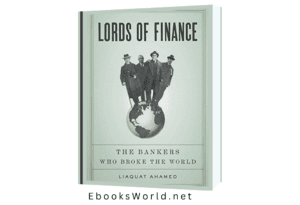Lords of Finance: The Bankers Who Broke the World

“Lords of Finance: The Bankers Who Broke the World” is a captivating historical narrative written by Liaquat Ahamed. Published in 2009, the book explores the lives and decisions of four central bankers during the interwar period, a time marked by economic turbulence, political upheaval, and ultimately, the Great Depression. The central figures are Montagu Norman of the Bank of England, Benjamin Strong of the Federal Reserve Bank of New York, Émile Moreau of the Banque de France, and Hjalmar Schacht of the Reichsbank in Germany.
Background and Setting: The narrative begins in the aftermath of World War I, a time when the global economy was in disarray. The Treaty of Versailles imposed heavy reparations on Germany, setting the stage for economic instability. The gold standard, a system tying national currencies to a fixed quantity of gold, was the prevailing monetary framework. Against this backdrop, the central bankers grappled with the complexities of managing their respective economies and maintaining the gold standard.
Character Profiles:
1. Montagu Norman (Bank of England): Norman, a charismatic and enigmatic figure, played a crucial role in shaping British monetary policy. He was deeply committed to the gold standard and believed in its stabilizing effects. Norman’s policies, however, contributed to the deflationary pressures that exacerbated the Great Depression.
2. Benjamin Strong (Federal Reserve Bank of New York): Strong, the powerful and influential head of the New York Fed, sought to balance the interests of Wall Street and Main Street. He played a key role in stabilizing the post-war economy but succumbed to illness in 1928, leaving a leadership void that impacted the global response to the impending crisis.
3. Émile Moreau (Banque de France): Moreau, representing French interests, was determined to safeguard French financial stability. His conservative approach to monetary policy, influenced by the trauma of World War I, contributed to the inflexibility of the international financial system.
4. Hjalmar Schacht (Reichsbank): Schacht, a pragmatic and resourceful banker, navigated the challenges facing Germany. He employed unorthodox measures to stabilize the German economy, but ultimately, his efforts were insufficient to prevent the country’s descent into hyperinflation.
Key Themes:
1. Gold Standard: The book delves into the strengths and weaknesses of the gold standard, a system that constrained the flexibility of central bankers. The commitment to gold often took precedence over the need for domestic economic stability.
2. Interconnectedness: Ahamed highlights the interconnected nature of the global economy and how the decisions of one central banker could have far-reaching consequences. The failure to coordinate policies effectively exacerbated the economic downturn.
3. Individual Agency: While the central bankers were constrained by the economic and political realities of their time, the book emphasizes the significant impact that individual personalities and decisions had on the course of history.
The Unraveling of the Global Economy:
The book meticulously traces the events leading up to the Great Depression, revealing how a series of interconnected factors, including the Wall Street Crash of 1929, banking failures, and the failure of international cooperation, culminated in a devastating economic downturn. The central bankers, despite their expertise and intentions, were unable to prevent the collapse.
Legacy and Lessons:
“Lords of Finance” serves as a cautionary tale about the challenges of managing a global economy and the limitations of economic orthodoxy. The book underscores the importance of effective international cooperation and the need for policymakers to consider the broader implications of their decisions.
Conclusion:
“Lords of Finance” offers a compelling narrative that weaves together economic history, biography, and the complexities of international finance during a pivotal period. It sheds light on the personalities and decisions that shaped the world economy in the early 20th century, providing valuable insights for understanding the dynamics of financial crises and the role of central bankers in times of economic turmoil.







